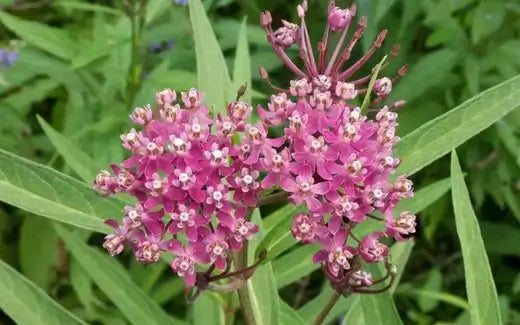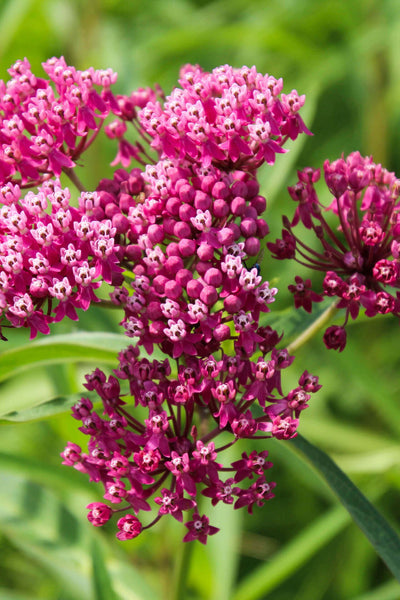Swamp Milkweed (Asclepias Incarnata)

Swamp milkweed is a native perennial found throughout most of the United States. According to the United States Department of Agriculture’s Natural Resources Conservation Service, this plant occurs naturally in every state except Washington, Oregon, California, Arizona, Hawaii, and Mississippi. The flowers are usually pink or mauve, but white and purple varieties have been cultivated. Swamp milkweed is often grown in flower gardens for its showy and fragrant blooms.
Swamp milkweed prefers damp soil and is often found growing near bodies of water or in low-lying areas such as river bottoms and swamps. Despite the name, swamp milkweed also does well in well-drained soil. Garden designers often use it in areas that do not drain particularly well, but this is not required. It does, however, have a deep taproot and does not transplant particularly well once established. This plant prefers full sun.
Like other milkweed plants, swamp milkweed has a milky sap that contains latex, alkaloids, and glycosides. The United States and Germany attempted to use milkweeds as a source of rubber during World War II, but the latex content was low, and commercialization was never achieved.
Swamp Milkweed attracts Butterflies
Butterflies are drawn to the powerful scent of swamp milkweed, and Monarch butterfly caterpillars feed exclusively on plants in this family. The alkaloids in the sap give these insects a bitter taste, and birds have learned to associate the bright colors of the caterpillars and the adult butterflies with an unpleasant dining experience. Viceroy butterflies mimic the adult Monarch's vivid orange and black coloration and benefit from its bitter reputation even though Viceroy caterpillars do not feed on milkweeds and, presumably, taste just fine.
Asclepias incarnate grows in upright clumps of fleshy white tubers. The plants emerge late in the growing season and typically reach three to five feet with multiple branched stems and narrow, lance-shaped opposing leaves. Blooms occur in the early to mid-summer months, and upward-pointing seed pods form when the flowering is done. When these seed pods ripen and split in late summer to mid-fall, they release flat, brown seeds attached to silky silvery-white hairs. The hairs act as parachutes and are readily burned by the slightest winds. All milkweed species disperse seeds in this manner.
Building the Perfect Butterfly Garden with Swamp Milkweed
Anyone who wants to develop an abundant butterfly garden should consider planting swamp milkweed (Asclepias incarnata). The hardy perennial serves as a vital food source for monarch butterfly larvae, drawing numerous other pollinating insects to the garden.
First, select a suitable location for planting. Swamp milkweed grows best in places with full sunlight for at least six hours daily. Because swamp milkweed grows naturally in wet meadows and stream banks, you should plant it in moist soil and possibly boggy soil. To improve water retention in soil without moisture, you should mix in organic matter like compost. These modifications will establish optimal growing conditions that enable swamp milkweed to thrive.
Buy your plants or seeds from trustworthy suppliers who avoid harmful pesticides. Monarch caterpillars and beneficial insects suffer damage from chemical residues. Despite many nurseries marketing their plants as “pollinator-friendly,” consumers should inquire about pesticide practices to ensure safety. To start your seeds, gently embed them into moist soil during autumn or early spring. Exposing seeds to cold temperatures during stratification effectively ends their dormancy stage, which results in higher germination success.
After swamp milkweed plants become established, several additional species will be planted to help attract different pollinators. Swamp milkweed looks stunning when planted alongside bee balm and black-eyed Susans. The combination of multiple blooming periods and various flower shapes attracts other insects and butterflies, keeping activity levels high throughout the growing season. A diverse garden ecosystem prevents pest problems by maintaining beneficial predator populations and fostering a strong and balanced environment.
Water your new plants frequently, especially when rainfall is scarce. Although swamp milkweed shows good resistance to drought conditions, it thrives better with regular watering, which leads to lush foliage and plentiful flowers. When your garden develops, eliminate invasive weeds and unwanted seedlings that could battle with your milkweed for essential sunlight and nutrients. Plant bases benefit from a two-inch layer of organic mulch that retains moisture and prevents weed growth but maintains a distance of a few inches from the stems to avoid rot.
Avoid applying broad-spectrum insecticides if you want your butterfly garden to thrive. Chemicals that target unwanted pests also harm essential pollinators and favorable insects. Use biological pest control techniques to manage aphids by attracting ladybugs or lacewings to your garden. Ensuring your milkweed plants stay healthy and the butterflies that depend on them requires maintaining a balanced ecosystem.
Establish shelter and additional food sources for the butterflies that visit your garden. Flat stones and decorative rock features serve as sunbathing spots, helping butterflies maintain their body heat. Visitors can access water from a shallow dish or a small puddling station. Providing these extra amenities helps establish an ideal habitat where butterflies can successfully live and grow.
Implementing these instructions lets you establish a beautiful butterfly habitat in your outdoor space. Swamp milkweed forms the foundation for a constantly changing display of bright flowers and elegant pollinators while helping you support crucial conservation work.


